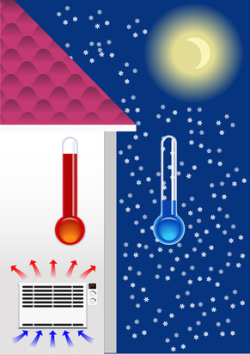The average single-family home in the United States costs about a thousand dollars to heat. In particularly cold areas, heating costs can run upwards of a couple thousand dollars in a year. This is not only costly, but it also puts a strain on the environment. Most homes are heated with carbon-based fuels like oil or natural gas. These are non-renewable resources and they cause carbon dioxide emissions. Yet sometimes they are cost effective. So they can be efficient in a financial context. Let’s take a look at the efficiency of different heating methods to determine which will help your budget, as well as the environment.
Natural Gas Heating
Natural gas provides ample dollar on dollar savings for home heating costs. Over half of all American homes rely on natural gas for heat. It is much more efficient than electricity or wood to heat an entire home. It costs about half as much as oil when it fuels a furnace or boiler. It can also be used for cooking and to power appliances. Some homes even make use of natural gas fuel cells that generate electrical energy so that it is not necessary for another electrical line to enter the home. From an environmental perspective, natural gas isn’t that efficient as it is a non-renewable resource. Human beings likely have around 100 years worth of natural gas reserves available for consumption. However, natural gas is the cleanest fossil fuel around. It creates about 90 percent fewer carbon dioxide emissions compared to coal.
Electric Heating
From a homeowner’s point of view heating with electricity is efficient. It is affordable yet it isn’t fantastic for the environment as the production of electricity obviously requires resources. Only about a third of the energy from oil, coal or gas turns into electrical energy. Many can’t control the source of electrical energy that heats their homes so inefficient coal can be used against their will. Electric heating is beneficial for the environment when it is derived from renewable sources like wind power. In terms of softening the blow to your pocketbook, electric heating can cut your winter heating bills if you utilize zonal heating controls and space heaters. This means that you should heat the rooms that you use and leave the others cold. If used to operate an air source heat pump, electricity’s cost is comparable to natural gas.
Oil Heating
Just over 8 million Americans use oil to heat their homes. Most of them are in the Northeast. Some homes in this part of the country had central heating systems implemented before natural gas was implemented far and wide. Certain homes have fuel storage tanks that are filled up throughout the winter. The average family that uses oil for heating purposes requires around 700 gallons per winter. The cost per gallon varies according to supply and demand.
Wood/Pellet Stoves
Wood is environmentally friendly when sustainably harvested from a forest. It is a renewable resource as fast growing trees can attain heights of 30 feet in merely 3 years. To create pellets, biomass fuel like wood, corn husks or paper are necessary. It is cheaper to heat a home with wood or pellets compared to fossil fuels. While wood and pellet stoves might be efficient, they aren’t possible or even ideal for many homeowners who’d prefer a more conventional heating method.
Each home heating method has unique advantages and disadvantages. If you are looking for a cost effective way to heat your home or a means of heating your home that benefits the environment, you have plenty of options to consider. Not sure which method is right for your home? Contact us for help.

